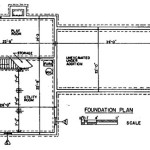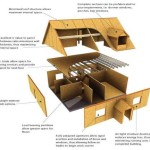A beach stilt house plan is a type of blueprint that provides instructions for constructing a house that is elevated on stilts, or tall pillars. These homes are often found in coastal areas as a way to protect them from flooding and storm damage. Beach stilt houses are typically built on a raised foundation, with the living quarters located on the second floor or higher. This design allows for airflow and ventilation beneath the house, which can help to keep the home cool and dry in hot and humid climates.
Beach stilt house plans typically include detailed instructions for all aspects of construction, from the foundation to the roof. The plans will also specify the materials to be used and the dimensions of each component. In addition to the basic construction plans, some beach stilt house plans also include landscaping and deck designs. These plans can help to ensure that your home is both functional and aesthetically pleasing.
If you are planning to build a beach stilt house, it is important to choose a plan that is right for your needs and the specific site conditions. You should also consider the cost of construction and the maintenance requirements before making a final decision.
Consider these important points when planning your beach stilt house:
- Flood zone: Determine the flood risk of your building site.
- Foundation: Choose a foundation system that is appropriate for your soil conditions.
- Elevation: Elevate your home high enough to protect it from flooding and storm damage.
- Wind resistance: Design your home to withstand high winds.
- Materials: Use materials that are resistant to moisture and salt.
- Ventilation: Provide adequate ventilation to prevent moisture buildup.
- Access: Consider how you will access your home during flooding.
- Utilities: Plan for the installation of utilities, such as water, sewer, and electricity.
- Maintenance: Be prepared to perform regular maintenance on your home, including inspections and repairs.
- Insurance: Obtain adequate insurance coverage for your home.
By following these tips, you can help ensure that your beach stilt house is safe, durable, and enjoyable for many years to come.
Flood zone: Determine the flood risk of your building site.
Before you start planning your beach stilt house, it is important to determine the flood risk of your building site. This will help you to choose the appropriate foundation system and elevation for your home.
There are a few different ways to determine the flood risk of your building site. One way is to check the Federal Emergency Management Agency (FEMA) flood maps. These maps show the areas that are at risk for flooding, and they can be found online at the FEMA website.
Another way to determine the flood risk of your building site is to talk to your local building official. They will be able to tell you if your building site is in a flood zone, and they can provide you with information about the flood risks in your area.
If your building site is in a flood zone, you will need to take steps to protect your home from flooding. This may include elevating your home on stilts, installing flood vents, and purchasing flood insurance.
By following these tips, you can help to ensure that your beach stilt house is safe from flooding.
Foundation: Choose a foundation system that is appropriate for your soil conditions.
The type of foundation that you choose for your beach stilt house will depend on the soil conditions at your building site. There are a few different types of foundation systems that are commonly used for beach stilt houses, including:
- Pile foundations: Pile foundations are a good option for building on soft or unstable soils. Piles are long, slender columns that are driven into the ground to support the weight of the structure.
- Caisson foundations: Caisson foundations are similar to pile foundations, but they are larger in diameter and are typically constructed of concrete. Caissons are also driven into the ground, but they can be used to support heavier structures than piles.
- Slab-on-grade foundations: Slab-on-grade foundations are a good option for building on stable soils. These foundations consist of a thick concrete slab that is poured directly on the ground.
When choosing a foundation system for your beach stilt house, it is important to consider the following factors:
- Soil conditions: The type of soil at your building site will determine which foundation system is most appropriate.
- Elevation: The elevation of your home will also affect the type of foundation system that you need. Homes that are elevated higher off the ground will require a more robust foundation system.
- Cost: The cost of installing a foundation system will vary depending on the type of system that you choose and the soil conditions at your building site.
It is important to consult with a qualified engineer to determine the best foundation system for your beach stilt house.
Elevation: Elevate your home high enough to protect it from flooding and storm damage.
One of the most important things to consider when planning your beach stilt house is the elevation of your home. Your home should be elevated high enough to protect it from flooding and storm damage.
The amount of elevation that you need will depend on the flood risk in your area. If you live in an area that is prone to flooding, you may need to elevate your home higher than someone who lives in an area that is less prone to flooding.
In addition to flooding, you also need to consider storm damage when determining the elevation of your home. High winds can cause storm surge, which is a wall of water that can damage or destroy homes that are not elevated high enough.
When determining the elevation of your home, it is important to consult with a qualified engineer. An engineer can help you to determine the minimum elevation that is required for your home, and they can also help you to design a foundation system that will support your home at the desired elevation.
Wind resistance: Design your home to withstand high winds.
Beach stilt houses are located in coastal areas that are prone to high winds. It is important to design your home to withstand these winds to prevent damage or destruction.
- Use strong building materials: The materials that you use to build your home will have a significant impact on its ability to withstand high winds. Choose strong materials, such as concrete, steel, or pressure-treated lumber.
- Reinforce your home’s structure: In addition to using strong materials, you should also reinforce your home’s structure to make it more resistant to wind. This can be done by adding hurricane straps, shear walls, and other structural reinforcements.
- Install impact-resistant windows and doors: Windows and doors are one of the most vulnerable parts of a home during a hurricane. Install impact-resistant windows and doors to help protect your home from wind damage.
- Secure your roof: Your roof is another important part of your home to protect during a hurricane. Make sure that your roof is properly attached to your home and that all of the shingles or tiles are securely fastened.
By following these tips, you can help to ensure that your beach stilt house is able to withstand high winds and other severe weather conditions.
Materials: Use materials that are resistant to moisture and salt.
Beach stilt houses are exposed to a variety of harsh environmental conditions, including moisture, salt, and wind. It is important to use materials that are resistant to these conditions to prevent damage to your home.
- Pressure-treated lumber: Pressure-treated lumber is treated with chemicals that make it resistant to rot and decay. This makes it a good choice for use in beach stilt houses, where the wood is exposed to moisture and salt.
- Concrete: Concrete is a strong and durable material that is resistant to moisture and salt. It is a good choice for use in foundations, walls, and floors.
- Stainless steel: Stainless steel is a corrosion-resistant material that is ideal for use in outdoor applications. It is a good choice for use in fasteners, hardware, and railings.
- Fiberglass: Fiberglass is a strong and lightweight material that is resistant to moisture and salt. It is a good choice for use in roofing, siding, and windows.
By using materials that are resistant to moisture and salt, you can help to ensure that your beach stilt house will last for many years to come.
Ventilation: Provide adequate ventilation to prevent moisture buildup.
Moisture buildup can be a major problem in beach stilt houses, as the salt air and humidity can cause mold and mildew to grow. It is important to provide adequate ventilation to prevent moisture buildup and keep your home healthy and comfortable.
- Install cross-ventilation: Cross-ventilation is the movement of air through a space from one side to the other. This can be achieved by opening windows and doors on opposite sides of the house. Cross-ventilation helps to remove moisture and stale air from the house.
- Use exhaust fans: Exhaust fans can be installed in bathrooms, kitchens, and other areas where moisture is likely to build up. These fans help to remove moisture from the air and prevent it from condensing on surfaces.
- Install a dehumidifier: A dehumidifier can help to remove moisture from the air, especially in humid climates. This can help to prevent mold and mildew growth.
- Keep your home clean: Moisture can build up on surfaces in your home, such as floors, walls, and furniture. It is important to keep your home clean to prevent mold and mildew growth.
By following these tips, you can help to ensure that your beach stilt house is properly ventilated and free from moisture buildup.
Access: Consider how you will access your home during flooding.
If you live in an area that is prone to flooding, it is important to consider how you will access your home during a flood event. Beach stilt houses are typically elevated on stilts or pilings, which can make it difficult to access the home during flooding. There are a few different options for accessing your home during a flood, including:
- Walkways: Walkways can be constructed to provide access to your home during flooding. Walkways should be elevated above the flood level and should be constructed of durable materials, such as concrete or pressure-treated lumber.
- Bridges: Bridges can be constructed to provide access to your home if it is located on an island or if the surrounding area is flooded. Bridges should be designed to withstand the force of floodwaters and should be constructed of durable materials, such as concrete or steel.
- Boats: Boats can be used to access your home if it is located on a body of water. Boats should be large enough to accommodate your family and belongings, and they should be equipped with safety features, such as life jackets and a bilge pump.
- Helicopters: Helicopters can be used to access your home if it is located in a remote area or if the surrounding area is impassable. Helicopters should be chartered from a reputable company, and the pilot should be experienced in flying in flood conditions.
It is important to develop a plan for accessing your home during a flood event. This plan should include the identification of multiple access routes and the necessary equipment and supplies. You should also practice your flood evacuation plan with your family so that everyone knows what to do in the event of a flood.
Utilities: Plan for the installation of utilities, such as water, sewer, and electricity.
When planning your beach stilt house, it is important to consider how you will install utilities, such as water, sewer, and electricity. There are a few different options for installing utilities in a beach stilt house, and the best option for you will depend on the specific location and layout of your home.
One option for installing utilities in a beach stilt house is to run the utilities underground. This can be done by trenching the utilities from the street to your home. Underground utilities are less likely to be damaged by storms or other events, but they can be more expensive to install than other options.
Another option for installing utilities in a beach stilt house is to run the utilities overhead. This can be done by attaching the utilities to the side of your home or by running them through the attic. Overhead utilities are less expensive to install than underground utilities, but they are more likely to be damaged by storms or other events.
A third option for installing utilities in a beach stilt house is to use a combination of underground and overhead utilities. This can be done by running the utilities underground from the street to a point near your home, and then running the utilities overhead from that point to your home. This option can be more expensive than either underground or overhead utilities alone, but it can provide the best of both worlds by reducing the risk of damage from storms or other events while also keeping the cost of installation down.
No matter which option you choose for installing utilities in your beach stilt house, it is important to have a qualified electrician or plumber do the work. This will ensure that the utilities are installed safely and correctly.
Maintenance: Be prepared to perform regular maintenance on your home, including inspections and repairs.
Beach stilt houses require regular maintenance to keep them in good condition and to prevent costly repairs down the road. Some of the most important maintenance tasks include:
- Inspecting the foundation: The foundation of your beach stilt house is what supports the entire structure, so it is important to inspect it regularly for any signs of damage. Look for cracks, chips, or other damage to the concrete or wood pilings. If you find any damage, it is important to have it repaired as soon as possible.
- Inspecting the exterior: The exterior of your beach stilt house is exposed to the elements, so it is important to inspect it regularly for any signs of damage. Look for cracks in the siding, loose or missing shingles, and any other damage that could allow water to penetrate the home. If you find any damage, it is important to have it repaired as soon as possible.
- Inspecting the interior: The interior of your beach stilt house is also important to inspect regularly. Look for any signs of water damage, such as mold or mildew. You should also check for any signs of pest infestation, such as termites or rodents. If you find any damage, it is important to have it repaired as soon as possible.
- Performing regular repairs: In addition to regular inspections, it is also important to perform regular repairs on your beach stilt house. This includes repairing any damage that you find during your inspections, as well as performing preventive maintenance tasks, such as cleaning the gutters and downspouts and replacing the air filters in your HVAC system.
By following these maintenance tips, you can help to keep your beach stilt house in good condition and prevent costly repairs down the road.
Insurance: Obtain adequate insurance coverage for your home.
Insurance is an important part of protecting your beach stilt house from financial losses due to damage or destruction. There are a few different types of insurance that you should consider for your beach stilt house, including:
- Homeowners insurance: Homeowners insurance provides coverage for the structure of your home, as well as your personal belongings. It also provides liability coverage in case someone is injured on your property.
- Flood insurance: Flood insurance provides coverage for damage to your home and belongings caused by flooding. Flood insurance is not included in homeowners insurance, so it is important to purchase a separate flood insurance policy if you live in an area that is prone to flooding.
- Windstorm insurance: Windstorm insurance provides coverage for damage to your home and belongings caused by high winds. Windstorm insurance is not included in homeowners insurance, so it is important to purchase a separate windstorm insurance policy if you live in an area that is prone to hurricanes or other windstorms.
- Additional living expenses insurance: Additional living expenses insurance provides coverage for the costs of living in a temporary home if your home is damaged or destroyed and you are unable to live in it. This coverage can help to pay for expenses such as rent, food, and transportation.
It is important to talk to your insurance agent to determine the right amount of coverage for your needs. You should also review your insurance policy regularly to make sure that it is still adequate.










Related Posts








